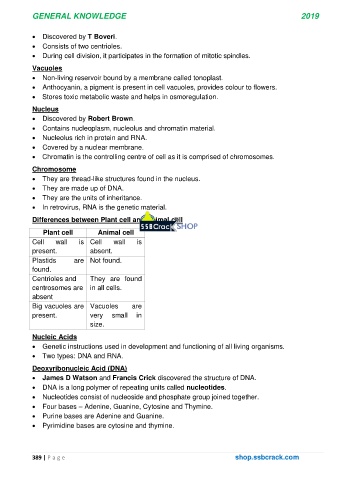Page 393 - General Knowledge
P. 393
GENERAL KNOWLEDGE 2019
Discovered by T Boveri.
Consists of two centrioles.
During cell division, it participates in the formation of mitotic spindles.
Vacuoles
Non-living reservoir bound by a membrane called tonoplast.
Anthocyanin, a pigment is present in cell vacuoles, provides colour to flowers.
Stores toxic metabolic waste and helps in osmoregulation.
Nucleus
Discovered by Robert Brown.
Contains nucleoplasm, nucleolus and chromatin material.
Nucleolus rich in protein and RNA.
Covered by a nuclear membrane.
Chromatin is the controlling centre of cell as it is comprised of chromosomes.
Chromosome
They are thread-like structures found in the nucleus.
They are made up of DNA.
They are the units of inheritance.
In retrovirus, RNA is the genetic material.
Differences between Plant cell and Animal cell
Plant cell Animal cell
Cell wall is Cell wall is
present. absent.
Plastids are Not found.
found.
Centrioles and They are found
centrosomes are in all cells.
absent
Big vacuoles are Vacuoles are
present. very small in
size.
Nucleic Acids
Genetic instructions used in development and functioning of all living organisms.
Two types: DNA and RNA.
Deoxyribonucleic Acid (DNA)
James D Watson and Francis Crick discovered the structure of DNA.
DNA is a long polymer of repeating units called nucleotides.
Nucleotides consist of nucleoside and phosphate group joined together.
Four bases – Adenine, Guanine, Cytosine and Thymine.
Purine bases are Adenine and Guanine.
Pyrimidine bases are cytosine and thymine.
389 | P a g e shop.ssbcrack.com

